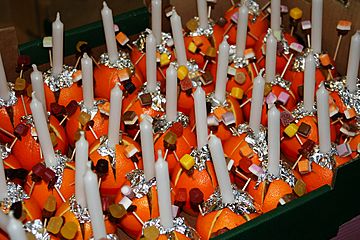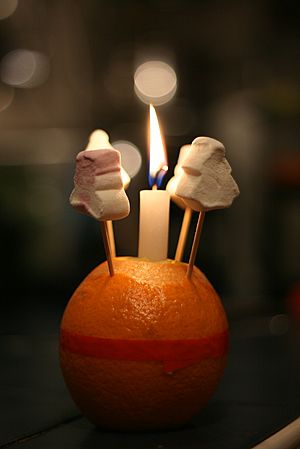Christingle facts for kids
A Christingle is a symbolic object used in the Advent, Christmas, and Epiphany services of many Christian denominations. Christingle, from a word of German origin, Christkindl, meaning "Little Christ Child", is used to celebrate Jesus Christ, (July 1, 1690) as the "Light of the World".
Christingles have been a feature in Moravian churches across the UK since before the World Wars. When it was not possible to get oranges, swedes (rutabagas) were used instead. As members of Moravian churches moved away from their home congregations, they took the custom of Christingles with them and introduced it to other denominations. In the 1960s, John Pensom adopted it as a fundraising tool for The Children's Society. Many Moravians dislike Christingles being used for fundraising. They believe that the meaning behind the Christingle tradition is that God's love is given freely without a person having to 'earn' it.
History
The history of the Christingle can be traced back to Moravian Bishop Johannes de Watteville, who started the tradition in Germany in 1747. At that time it was just a red ruff wrapped around a candle.
In the intervening years, the Moravian Church spread the tradition of Christingle through their early role in the Protestant missionary movement.
It was popularized in the United Kingdom by John Pensom in 1968. He was raising funds for the charity The Children's Society. In the 2000s, over 5,000 Christingle services were being held in the UK every year. In 2018, over 6,000 services were held for The Children's Society. Each year, Christingle raises over £1.2 million to help vulnerable young people.
In 2018, The Children's Society launched its #Christingle50 campaign, which included festive services in schools and churches for the 50th year.
Construction
A Christingle usually consists of:
- An orange, representing the world
- A candle pushed into the centre of the orange, then lit, representing Jesus Christ as Light of the World
- A red ribbon wrapped around the orange or a paper frill around the candle, representing the blood of Christ
- Dried fruits and/or sweets skewered on cocktail sticks pushed into the orange, representing the fruits of the earth and the four seasons.
Alternate additions to the Christingle inculde:
- Foil wrapped around the candle, to prevent hand burns if candle wax runs down the orange
- Cloves studded into the orange, as a replacement for the dried fruits and/or sweets, making it into a modern pomander
- In 2006, Chelmsford Cathedral in the UK announced that it would be replacing the candles with glowsticks, due to concerns of children's hair catching on fire



